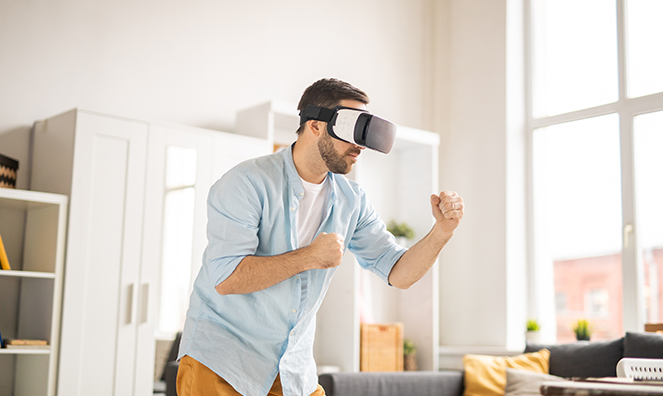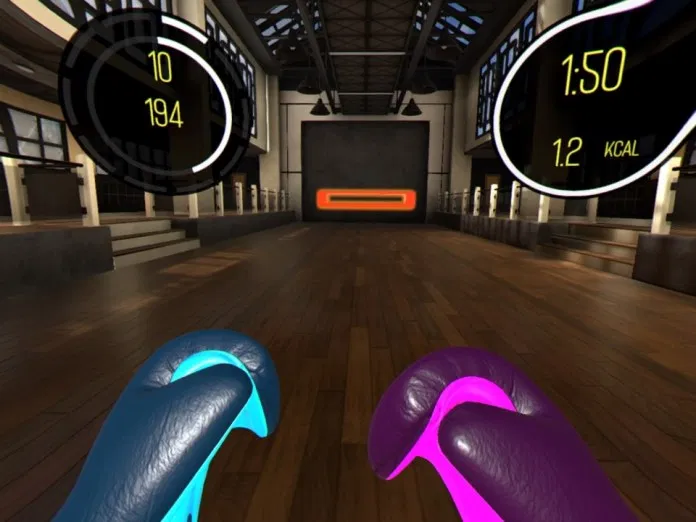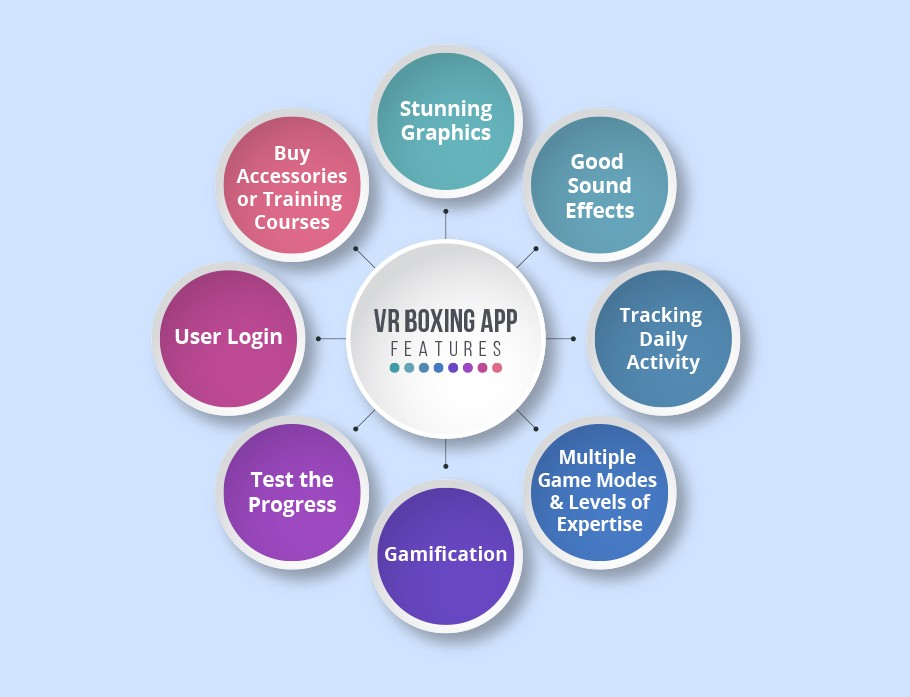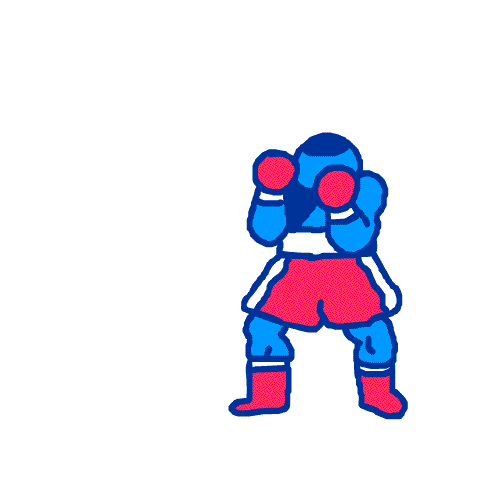4244
Build a VR Boxing App: A Guide to Features, Steps, and Monetizing
07 Oct, 2020
15 min read
4244
07 Oct, 2020
15 min read

“But listen – a movie that gives one sight and sound. Suppose now I add taste, smell, even touch, if your interest is taken by the story. Suppose I make it so that you are in the story, you speak to the shadows, and the shadows reply, and instead of being on a screen, the story is all about you, and you are in it. Would that be to make real a dream?”
That’s what American writer Stanley G. Weinbaum, in 1953 talks about in his novel Pygmalion Spectacles.
Way before the world had the first prototype of a VR headset, these magic spectacles foreshadow the predominance of headsets and the virtual world.
From using VR in education to military training, this much-hyped technology is growing at a fast pace. Hundreds of companies have dipped their toes into Virtual Reality by integrating it in marketing strategies, offering virtual tours of product listing, or developing a VR app.
Apps for boxing workout is a popular industry where VR shines. So, this article is for anyone interested in building a VR boxing app.
What are the characteristics of a VR boxing app? How to build it? Let’s dive right into it to find out!
Topic Outline
We have all been in a workout slump. Those same treadmill sessions, body movements, and cardio sessions every day. Even the most exciting workout playlist won’t cheer you up. Mundane life it is! Truly.
Now picture this. There is an extraterrestrial war going. UFO spaceship attacks Earth. You set up on a jet along with different missiles, and fly up. You are racing in space and fighting to protect your planet. Cool stuff! Also, a bonus– you burn calories. This, on your mobile device.
Now that’s the charm of virtual fitness. Without setting foot inside a gym or your Pilates classes, you can shred the excess fat which is fun.
With an aim to give fitness immersive experiences through opaque headsets, VR has taken the fitness industry by storm. VR-based gyms, VR-based workout has become increasingly common.
“People can use VR to transport to any environment they desire—the moon, the beach, under the ocean, or wherever they want. Using VR, people can even load a 3D model of a boxing ring and practice ducks and slips and then do yoga in a Japanese Zen garden without ever leaving their home.” – Mat Chacon, the CEO of VR company Doghead Simulations.
At times, even the most dedicated exercisers struggle to hit the gym daily. VR breaks up the monotony by making the user feel like he is watching a 3D movie. Users feel like they are on an adventure and therefore are likely to stay motivated.
For example, the game VZfit by Virzoom. You can play it on Oculus Quest or Go. Using the power of virtual reality, and any stationary bike, the game transports you to worlds where you must pedal to move. You race, battle and fly by yourself or with others in Virtual Reality: fly a Pegasus, race F1 cars, battle as a tank or an attack helicopter, lasso bandits, or cycle through the countryside. The VR headset shows you the gameplay, a sensor on the bike increases or decreases your speed based on how hard you pedal, you turn by leaning your head and activate in-game features with a controller that you can attach to the bike’s handlebar.
This is too much fun!
Gamification is the technique of applying game elements to motivate or influence behavior. Gamifying activities is the latest trend especially among fitness apps. It makes fitness more effective and engaging.
With the use of scores, rewards, and instant feedback in gamified workouts, users can easily track their gain or loss. By using virtual reality in fitness gamification, you can push people to go beyond their limits by focusing on winning the game rather than indulging in a serious workout.
For instance, the Black Box studio in San Francisco offers virtual reality workouts for its members. They use resistance bands and weights to create a full-body workout during the game. Members of the gym say they feel less energy exerted than the actual effort.
Want to know more about how you can integrate game elements into your fitness business?
There are several VR boxing games. The reason for their popularity is because they provide a great workout + fun. Check out these VR boxing games that everybody is talking about.
BoxVR is the award-winning VR fitness game that includes 20 hours of fun workout to destroy calories in the most adventurous way.

It offers one of the most intense workouts in all of VR that is full of dramatic flair.


Tell us what features you want in your VR boxing, and we will help you find what works best.
Suppose you want to build a house. The first thing you will do is scribble your plan on a piece of paper– where would be the dining area, where would be the bedroom, etc. Then you approach an architect and tell him what you want. After considering your idea, he will create a blueprint before he starts working with bricks and cement.
In the same way, a wireframe is a blueprint that focuses on your app’s structural elements. A wireframe is the backbone of any mobile app design that enables you to test your product concept and define a user journey. It lets designers explore layout and interaction concepts by gathering insights from user and stakeholder feedback.
While working on wireframes for VR boxing apps, remember that it hardly has anything to do with the design elements but its purpose is to illustrate the core components and layout the schemes.
For this, first, you need to map out user flow. A user flow is steps that a user will take to reach a specific goal. What action will the user take after signing in? What happens when the user selects the desired workout level? These questions will help decipher the number of screens you will need and will help decide the flow the user will follow.
Here’s a rough sketch of how a user flow for a VR boxing app will look like.
App> Login with Facebook> Enter Details> Select Experience Level> Choose opponent> Play> Share the win on social media.
You can create the sketch on paper or digital wireframes. You can use tools like Balsamiq Wireframes, Wireframe.cc, Figma, Pencil Project, etc. Digital or on a paper whatever it is but make sure you do not lose it. Because it will serve as a foundation while discussing with developers.
Here, at Biztechcs, we finalize the wireframe after taking a few feedback cycles from the client. Only then we move on to the design phase. This initial communication helps to identify problems in the early stages and prepare your project for further design creation and coding.
Other best practices for wireframing include:
The performance of your VR boxing app depends on the method of development. And choosing a method is based entirely on specific needs and budget. However, we are sharing some information on common development methods to help come to a decision.
Native app development is using platform-specific programming languages and software development kits. If you are building an app for iOS, or Android, or both then you need to build it separately for each platform. Because every platform has its programming language. So, if you are building an app for both platforms, it’s going to be time-consuming unless you have different people working on different platforms.
If you keep the time factor aside, native apps are highly reliable, secure, and responsive. This method offers the best performance and can take complete advantage of OS features to offer a unique experience.
If you think native could be both time and money consuming then hybrid is a good alternative. Moreover, these apps have the speed of a regular web app and the UX is similar to a native app. The most preferred language for hybrid apps is Javascript. So, if you can find an expert who can code for both iOS and Android at the same time then it’s a win. Hybrid apps have a good market reach but if your app has complex features and functionalities, you want to think again.
As the name suggests, it offers the scope of delivering apps across multiple platforms simultaneously. These apps are cost-effective and have a quicker development time. Moreover, they provide a unified look across different platforms.
If you are looking for a secret sauce of building a robust, smooth, and functional app, it lies in the technology stack. Technology stack is the combination of platform, programming languages, interface designing tools, database, and testing frameworks– everything you need to develop an app. Mobile development technology stack has four core components-
Tech Stack for Android
Tech Stack for iOS
Tech Stack for Cross-Platform
Need the best tech stack for your VR boxing application? Here’s a list of factors to consider before choosing the tech stack:
For a user, an app can either be good or bad. There is no in-between. And how do they decide that? By UI/UX. A good mobile application is the one which enables easy and effective interaction with the user (that’s user interface) and the one which provides the best experience to users (user experience).
It’s important to focus on mobile UI/UX because that’s what increases ROI by making the user journey smooth in the app.
Let’s have a look at mobile UI/UX common practices that you need to know.
MVP (minimum viable product) is about testing your project idea and discovering what will work to target your customer. The aim of MVP is to make you think about the most essential features of the mobile app.
Think what could be the core features that your VR boxing app needs to function smoothly? Start with building a workable product based on those minimum features for early users. Gather feedback from the users and improve the app further. This strategy will save you a good amount of time and money.
Identifying a good development company for your project is not an easy task. Developing a VR boxing app is no cakewalk. You need support from a company who has the technical expertise and in-depth knowledge to implement it successfully. Choose a team of mobile app developers, 3D artists, UI/UX design experts for creating the most amazing interactive experience.
Congratulations, your VR boxing app is ready for release.
Post the launch, there are two things to keep in mind.
(a) Market the app. What’s the use of launching if people do not know about it? Begin with promoting your app on social channels like Facebook, Instagram, LinkedIn, Pinterest. If you want to target the youth, make sure you are active on platforms like Snapchat, and Tiktok.
Posting videos on YouTube is another good way to market the app. Start making videos on app demonstrations. Spread the word through blogs, emails, etc. To get long-term results, focus on SEO tactics. This will drive huge traffic on your site via search engines.
(b) Continuously work on improving the app by incorporating the feedback by users in future updates.
Now it’s time to turn your app into a profit-generating tool. Check out these effective ways to earn money from your VR boxing app.

We hope this guide helps you build a VR boxing app that has an extraordinary and immersive experience.
If you need any help with creating the app, our team will be happy to help you out!
All product and company names are trademarks™, registered® or copyright© trademarks of their respective holders. Use of them does not imply any affiliation with or endorsement by them.

Odoo
7718
By Biztech
04 Jul, 2025
Odoo
369
By Devik Gondaliya
02 Jul, 2025

Odoo
636
By Devik Gondaliya
25 Jun, 2025